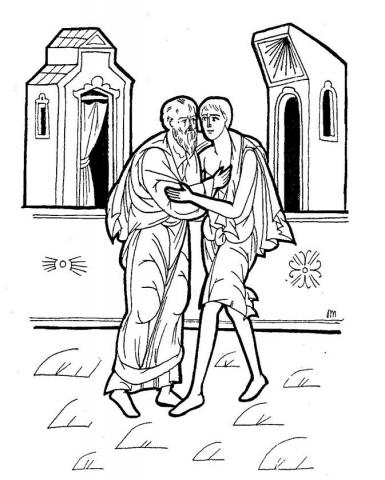Prodigal Son
THE PRODIGAL SON
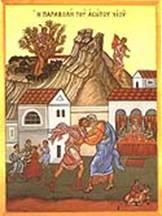 Objectives:
Objectives:
- Children should be able to tell the story of the Prodigal Son in their own words.
- Children should know that God forgives us even when we do something we shouldn’t.
Possible Lesson Plan:
- Open with prayer.
- Read the story of the Prodigal Son in the Beginner’s Bible, pages 397-404, the Children’s Bible Reader, pages 207-209, or the Read with Me Bible, pages 344-349. Supplement with the Golden Children’s Bible, pages 416-417, if desired. Where did the son go? What did he do with his money? Where did he end up, doing what? Why did he go back to his father? What did he say? What did his father say?
- True/False Questions:
True False
The son left home with his money. The son stayed home with daddy.
The son spent all his money. The son saved his money carefully.
The son had to feed the pigs. The son worked in the market.
The father was happy the son came home. The father hated the son.
Add the Prodigal Son's Pig to your timeline:
- Talk a bit about the words “I’m sorry”: These are powerful words. When do we say them? Have the children think of some times they have said them or heard someone else say them. What do we mean by saying “I’m sorry”? Did the Prodigal Son say, “I’m sorry”? How did the father respond? How do we respond when someone says they are sorry? Sometimes it’s not so easy to forgive. What if your friend broke your favorite toy and said, “I’m sorry”? Is it easy to forgive when the toy is still broken?
- Take a pigpen pledge: Review the story. The Prodigal Son was in the pigpen. He realized his sin and his father’s love – then he had to take a step. He had to get up and leave the pigpen and take a step towards his father! Picture this with the students. Then have each in preparation for Lent consider his or her own pigpen. What one single step can he or she take during Great Lent to move towards the Lord? Increased prayer time? Scripture reading each day? Lenten services? Improved fasting? Visiting the sick? Let each student actually write down the step he will take to draw nearer to the Father.
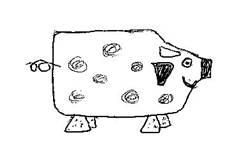 Make a Piggy Bank: Take a gallon milk or juice plastic container. Turn it on its side so the handle is on top. Glue eyes just below the handle on both sides, 4 corks or bottle tops for feet, pink felt ears, and paper circles for spots all over the pig’s body. Twist a pipe-cleaner into a tail and poke it into the plastic behind. Draw on a mouth. Finally, cut a slit in the top for coins. All during Great Lent, we will each collect coins at home (from the sofa cushions, off the floor, by doing chores, etc.) and will bring them in to class to put in the class Piggy Bank to give to the IOCC at Pascha.
Make a Piggy Bank: Take a gallon milk or juice plastic container. Turn it on its side so the handle is on top. Glue eyes just below the handle on both sides, 4 corks or bottle tops for feet, pink felt ears, and paper circles for spots all over the pig’s body. Twist a pipe-cleaner into a tail and poke it into the plastic behind. Draw on a mouth. Finally, cut a slit in the top for coins. All during Great Lent, we will each collect coins at home (from the sofa cushions, off the floor, by doing chores, etc.) and will bring them in to class to put in the class Piggy Bank to give to the IOCC at Pascha.
- Alternate Craft idea: Pig paper bag puppet. Take a paper bag. Use the templates below for either the piggy bank or the bag puppet. Glue the verse to the bottom of the bag. Write the verse on the bottom of the bag: “I shall arise and go unto my Father and shall say unto Him, ‘Father, I have sinned against heaven and before thee, and am no more worthy to be called thy son.’”
- Close with prayer. Ask specifically for each child to be faithful to his “Pigpen Pledge”.
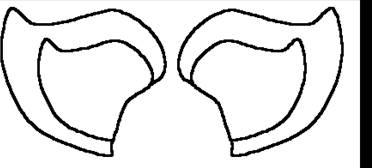
Ears
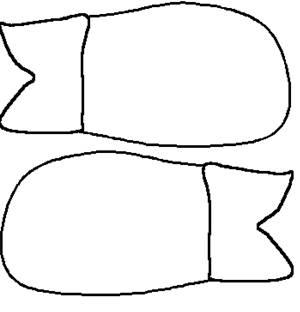
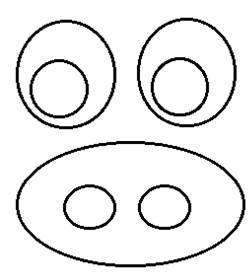 Eyes and nose Arms
Eyes and nose Arms